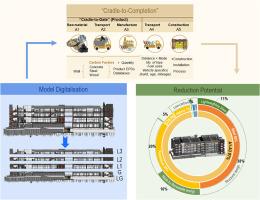bim集成的预制建筑LCA框架,具有自动基准测试和可视化决策支持
IF 7.6
1区 工程技术
Q1 CONSTRUCTION & BUILDING TECHNOLOGY
引用次数: 0
摘要
建筑行业面临着减少温室气体(GHG)排放的压力,前期隐含碳正在成为建筑环境碳足迹的重要贡献者。由于电网脱碳导致运营排放下降,与材料生产和建筑活动相关的排放的相对重要性继续增长。由于预制具有提高材料效率和减少现场浪费的潜力,因此作为一种减少隐含碳的策略,预制引起了人们的关注。然而,由于缺乏全面的基准和标准化的评价框架,量化其效益仍然是一项挑战。本文利用建筑信息模型(BIM)-为预制钢框架建筑量身定制的集成碳会计框架。该框架结合了生命周期评估(LCA)方法,并通过实际案例项目进行了演示。使用Power BI开发了一个动态、参数化的碳评估仪表板,实现了自动化材料提取、基于场景的排放分析和减排潜力的可视化。结果表明,如果在生产中最大限度地采用材料替代和可再生能源等脱碳策略,铝和结构钢等材料分别可以实现15.60%和10.91%的碳减排。其他策略,如轻钢、可再生能源铝、施工期间的可再生电力和再生混凝土,分别减少了11%、16%、1.4%和0.2%的潜在产量。结果很容易在交互式仪表板中计算出来。研究结果强调了bim工作流程在支持早期碳评估方面的有效性,并为类似的施工方法提供了基准,有助于在建筑环境中实现更广泛的脱碳目标。本文章由计算机程序翻译,如有差异,请以英文原文为准。

BIM-integrated LCA framework for prefabricated buildings with automated benchmarking and visual decision support
The construction sector is under pressure to reduce its greenhouse gas (GHG) emissions with upfront embodied carbon emerging as a significant contributor to the built environment’s carbon footprint. As operational emissions decline due to grid decarbonisation, the relative importance of emissions associated with material production and construction activities continues to grow. Prefabrication has garnered attention as a strategy for reducing embodied carbon due to its potential for enhanced material efficiency and reduced on-site waste. However, quantifying its benefits remains a challenge due to a lack of comprehensive benchmarks and standardised evaluation frameworks. This paper utilises a Building Information Modelling (BIM)-integrated carbon accounting framework tailored for prefabricated steel-framed buildings. The framework incorporates life cycle assessment (LCA) methodologies and is demonstrated through a real-world case project. A dynamic, parametric carbon evaluation dashboard was developed using Power BI, enabling automated material take-offs, scenario-based emission analysis, and visualisation of reduction potentials. Results show that materials such as aluminium and structural steel present substantial opportunities for carbon reduction of 15.60 % and 10.91 %, respectively, when combined with the maximum adoption of decarbonisation strategies such as material substitution and renewable energy in production. Other strategies such as lightweight steel, renewable-energy aluminium, renewable electricity during construction, and recycled concrete, yield potential reduction of 11 %, 16 %, 1.4 %, and 0.2 %, respectively. The results are readily computed in the interactive dashboard. The findings highlight the efficacy of BIM-enabled workflows in supporting early-stage carbon assessments and provide a benchmark for similar construction methods, contributing to broader decarbonisation targets in the built environment.
求助全文
通过发布文献求助,成功后即可免费获取论文全文。
去求助
来源期刊

Building and Environment
工程技术-工程:环境
CiteScore
12.50
自引率
23.00%
发文量
1130
审稿时长
27 days
期刊介绍:
Building and Environment, an international journal, is dedicated to publishing original research papers, comprehensive review articles, editorials, and short communications in the fields of building science, urban physics, and human interaction with the indoor and outdoor built environment. The journal emphasizes innovative technologies and knowledge verified through measurement and analysis. It covers environmental performance across various spatial scales, from cities and communities to buildings and systems, fostering collaborative, multi-disciplinary research with broader significance.
 求助内容:
求助内容: 应助结果提醒方式:
应助结果提醒方式:


